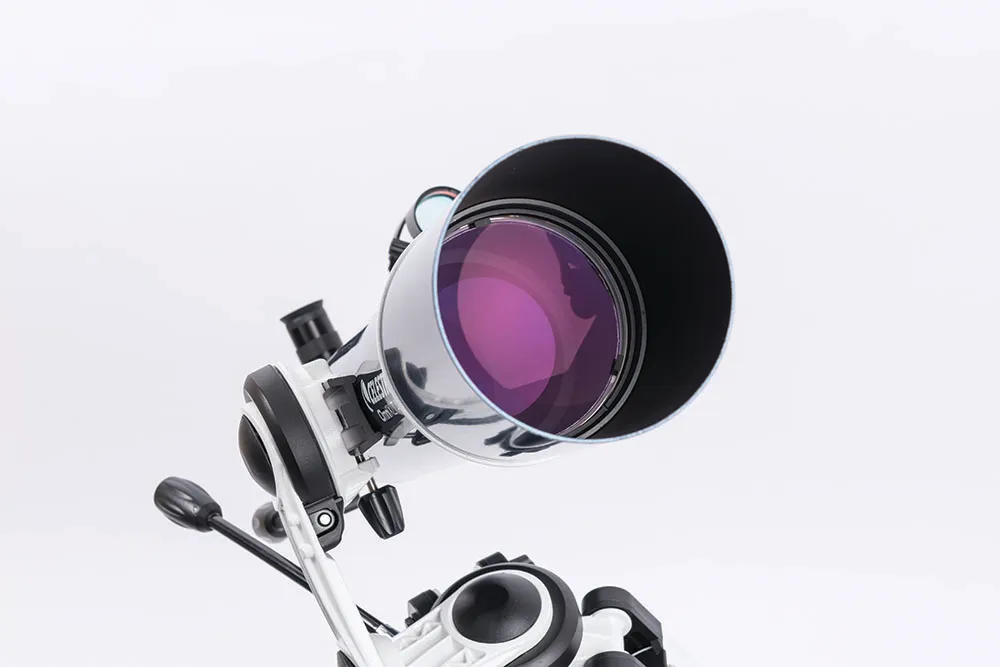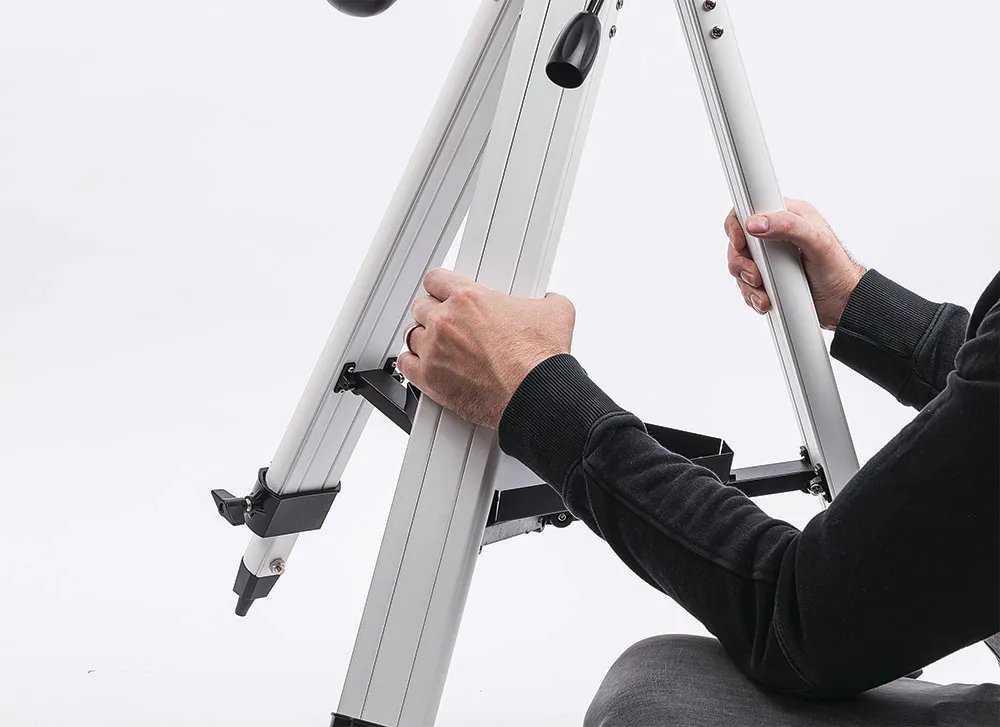For anyone beginning their journey to view the wonders of the night sky there’s a bewildering choice to be made when it comes to deciding what to buy.However, help is at hand in the shape of Celestron’s Omni XLT AZ 102 system.
Not only does it come with a fully coated 4-inch, f/6.5 scope, but there’s also a StarPointer Pro finder, a 25mm 1.25-inch Plössl eyepiece, an erect-image diagonal, a sturdy altaz mount with slow-motion controls and a lightweight yet firm tripod packaged alongside.
Putting it together is a quick and relatively simple process as the mount and tripod are already assembled.
It only takes a moment to attach the optical tube to the mount via its Vixen-style bar, add the finder, diagonal and eyepiece.
The telescope is designed so that you can use it for both astronomical and terrestrial viewing, but this review concentrates on its uses for astronomy.
It’s worth noting, however, that if you wish to use it for something like birdwatching, the mount’s single arm can be aimed so the scope points downwards.
You can achieve this by unscrewing the black circular cover on the bottom of the arm then using an Allen key to undo the screws and make the adjustment.
For astronomical purposes the mount can be moved manually in both altitude and azimuth planes via the slip clutches.
For zeroing in on a chosen target the StarPointer Pro finder provides a non-magnified view of the sky.
Simply turn on the red LED and it projects a lovely, dual-circle reticule that we found more satisfying to use than the typical red-dot finders we’re accustomed to.
There is one caveat though: its open design does tend to dew up quicker than you might expect.
This telescope features in our list of the best telescopes for beginners.

Pin-sharp views
Turning skyward, we manually located the bright star Altair in Aquila and, after centring it, moved it back and forth across the view of the supplied 25mm eyepiece.
We were pleased with the quality that allowed the star to remain pin-sharp almost to the edge of the view, which is good for wide-field targets.
We moved on to Albireo in Cygnus and were treated to a beautiful orange and sky-blue pair that was very tight at that magnification.
Swapping to our own 9mm Plössl and increasing the magnification from 26x to 73x, the view was gorgeous.
We then aimed at Iota Cassiopeiae, a tight, triple star system and could just about split the three of them.
The wide-field of view with the 25mm eyepiece allowed us to enjoy all of the Pleiades star cluster in one go, with a hint of the nebulosity drifting away from the star Merope.
Next we turned to the Andromeda Galaxy and found we could fit its core and its two companions, M32 and M110, into the view.
We even caught a glimpse of the northern dark lane during the moments when the seeing conditions were good.
Globular cluster M13 was small in the supplied 25mm eyepiece but with our own 9mm eyepiece we got a strong hint of several stars being resolved.
Upping the magnification further with our 2x Barlow lens really pushed the limit of the scope’s usability.
We also used the scope to catch the planetary gathering of Jupiter, Venus and Mars in the morning sky.
With the supplied eyepiece, Jupiter was quite small, but the Galilean moons were evident.
Our 9mm eyepiece allowed us to spot the two bands and polar hoods, and revealed a lovely phase on Venus.
The Moon also proved lovely and detailed through our 9mm eyepiece.
Overall this scope can deliver some good views for its size but as it can’t track stars, its potential for astrophotography is limited to quick shots of the Moon, which we managed to do using both a DSLR and smartphone.
If you want a nice simple to use yet optically good system, the Omni XLT 102 delivers on what it promises.

Lightweight and portable
One of the things that we enjoyed most about the Omni XLT AZ 102 was its lightweight and highly portable design.
Sometimes you just want something that you can set up and point at the sky quickly, and the Omni XLT AZ 102 excels at this.
Weighing just 6.2kg means it can be easily carried and although the tripod is light, it’s sturdy enough to allow you to move the whole assembly around your observing site for optimal views and take it on trips to catch rarer events.
Coming almost entirely preassembled means you can have it up and running in no time.
We also found that with the adjustable legs we could spend more time sitting while enjoying the night sky, rather than trying to peer up or over the scope at awkward angles, which sometimes happens with some systems.
This makes it an ideal beginners’ scope that will provide hours of viewing pleasure coupled with dark skies to get the most out of the optics.
Optics
The front lens is 4 inches in diameter and has a focal length of 660mm, which gives a focal ratio of f/6.5. All the optical surfaces are coated with Celestron’s XLT coating for maximum transmission of light and give crisp views of the brighter deep-sky objects.
Diagonal and eyepiece
The erect-image diagonal gives right-way-up views for astronomical and terrestrial viewing, and the telescope is supplied with one eyepiece – a 25mm, 1.25-inch-fit Plössl. The eyepiece gives a nice wide field of view of almost 2° and a magnification of 26x with this scope.
Mount and slow-motion controls
Although this is a basic mount and tripod, it’s simple to operate and uses worm gears for smooth tracking of objects. Slip clutches allow big adjustments for quick and easy pointing, while the manual slow-motion controls allow you to make fine adjustments smoothly.
Finder
The StarPointer Pro is a zero-magnification finderscope that looks elegant and futuristic. It projects a dual-circle reticule rather than a simple red dot and its intensity can be controlled by the knob underneath. We did, however, find it had a tendency to dew up quickly due to its open design.
Focuser
The focuser is a rack-and-pinion design with a screw on the top to lock the focus – useful if you add a camera or heavy eyepiece to the system. There’s ample focus travel and we found it did the job asked of it with only a little play.
Vital stats
- Price £325.00
- Aperture 102mm (4 inches)
- Focal Length 660mm (f/6.5)
- Weight 6.2kg
- Supplier David Hinds
- Telephone 01525 852696
- Websitewww.celestron.uk.com
This review originally appeared in the January 2016 issue of BBC Sky at Night Magazine.
